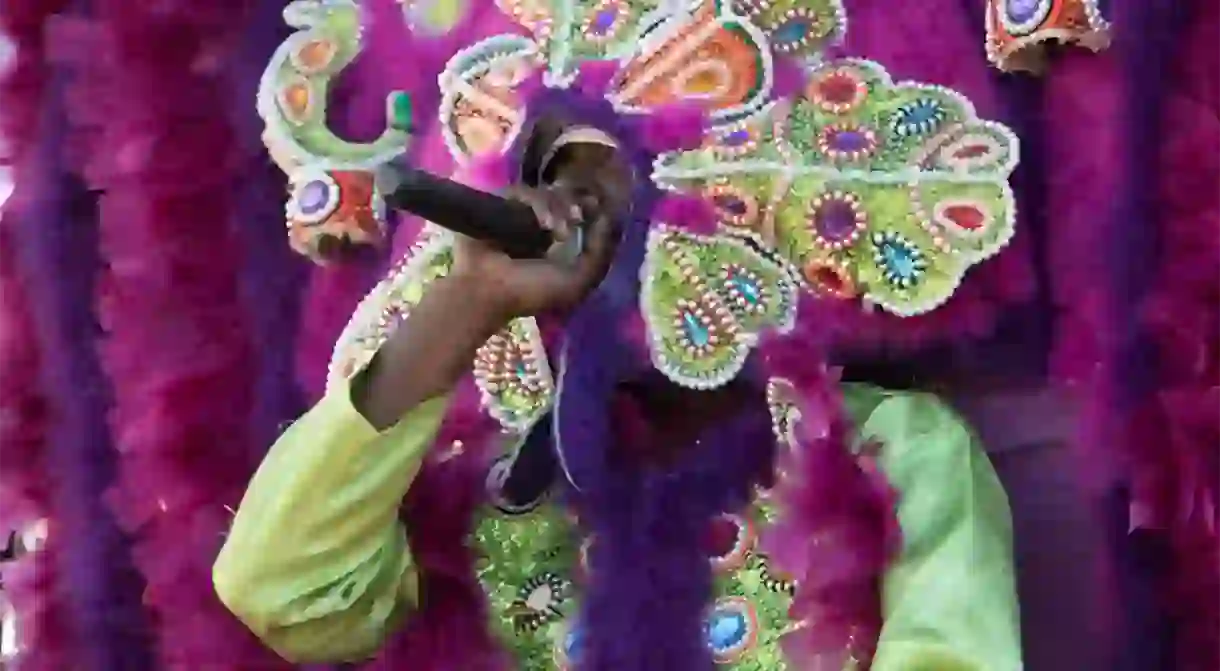New Orleans’ Mardi Gras Indians: More Than Just a Pretty Suit

Mardi Gras Indians are among the most iconic images associated with New Orleans and the city’s rich historical traditions. These eye-catching individuals represent the melding of disparate cultures in New Orleans’ diverse traditions, but their stunning attire and performances and what they represent go far beyond just Mardi Gras.
History of the Mardi Gras Indians
Mardi Gras Indians have been an integral part of New Orleans history as far back as the mid-19th century or earlier, but the foundations of this tradition date back even farther. By 1740, African slaves had already created a cultural hub, known as Congo Square, to partake in their native music and dance. During the late 1740s and 1750s, many runaway slaves had encountered Native Americans for the first time after fleeing to Louisiana’s swamplands.
In the early days of Mardi Gras in New Orleans, slavery and racism prevented many Africans and, later, African-Americans from participating in the traditional krewes, as many only permitted membership by invitation. While the specifics of the Mardi Gras Indians’ founding is debated, black communities in New Orleans began organizing their own krewes.

They named their krewes after imaginary Native American tribes based on their streets or gang, such as the Wild Magnolias or 9th Ward Hunters, and began parading and performing on Mardi Gras Day (or Fat Tuesday) in colorful, elaborate costumes and headdresses. Mardi Gras Indians and those in their community invest countless hours and dollars in creating these folk art masterpieces, which continue to astound New Orleans’ residents and visitors today.
Beyond parading in their costumes, Mardi Gras Indians also typically participate in call-and-response chanting, often accompanied by tambourines or other hand percussion instruments. But this vocal style and tradition has also made its way into other genres popular in the city, such as New Orleans funk, soul, and R&B. The tribes then parade through the city streets to “battle”music in an amiable competition to see which tribe’s chief is the best dressed.
Beyond Fat Tuesday
Can’t make it to New Orleans for the Mardi Gras season? There are still other opportunities to see the Mardi Gras Indians. Many Mardi Gras Indian tribes will don masks and parade on St. Joseph’s Day (March 19) and the nearest Sunday (“Super Sunday”). Mardi Gras Indians are also known to appear in full dress at local festivals, such as the New Orleans Jazz & Heritage Festival, and special events, such as neighborhood second lines.
Mardi Gras Indian history and costumes on display
New Orleans has several museums either entirely dedicated to Mardi Gras Indians or at least featuring one or more exhibits. The Backstreet Cultural Museum features a comprehensive collection of artifacts related to Mardi Gras Indians and a host of other traditions that took root in New Orleans African-American communities (such as jazz funerals and social aid and pleasure clubs). The Mardi Gras Museum—housed in the same building as the French Quarter restaurant Arnaud’s—offers a collection of vintage photographs, Mardi Gras costumes, Carnival masks, krewe invitations, and party favors. In the Lower Ninth Ward neighborhood, House of Dance & Feathers display an array of cultural artifacts collected by Ronald W. Lewis in his time spent with the Mardi Gras Indians, Social Aid & Pleasure Clubs, and Skull & Bone Gangs. The Golden Feather Mardi Gras Indian Gallery—at the border of the French Quarter and Tremé neighborhoods—also collects Mardi Gras Indian garb, which can be viewed by reservation. And the Mardi Gras Museum of Costumes and Culture showcases various Mardi Gras-related pieces, including Mardi Gras Indian costumes and headdresses.

Backstreet Cultural Museum, 1116 Henriette Delile St, New Orleans, LA, USA, +1 504 577 6001
Mardi Gras Museum at Arnaud’s, 813 Bienville St, New Orleans, LA, USA, +1 504 523 5433
House of Dance & Feathers, 1317 Tupelo St, New Orleans, LA, USA, 1 504 957 2678
Golden Feather Mardi Gras Indian Gallery, 704 N Rampart St, New Orleans, LA, USA, +1 504 258 4282
Mardi Gras Museum of Costumes and Culture, 1000–1010 Conti St, New Orleans, LA, USA, 1 504 218 4872













